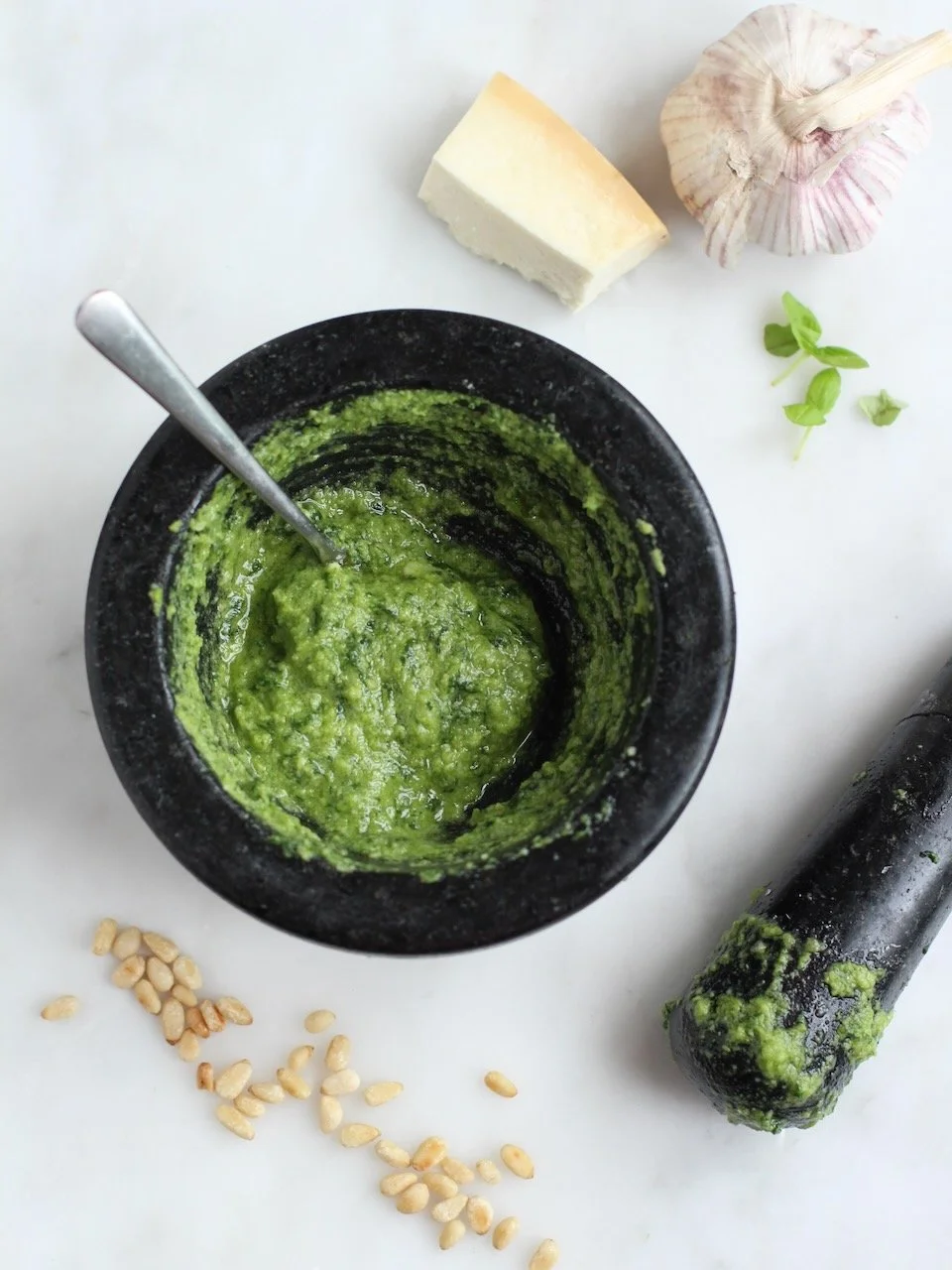Consuming Passions: Pesto
Ceri Jones is a huge fan of pesto! In her contribution to ckbk’s Consuming Passions strand, the chef and cookbook author tells us how she first enjoyed pesto from a jar, but then discovered the joy of making her own, including its many regional and seasonal variations. Ceri also shows some of the multitudes of ways pesto can be used in cooking. Yes, it’s a quick and easy sauce for pasta, but it is so much more besides. So dig, out your pestle-and-mortar and let’s get pesto-ing!
By Ceri Jones
I was first introduced to pesto via my Mum’s cooking. It was the mid 1990s and pasta was a staple weeknight dinner for us—hugely influenced no doubt by our trips to stay with my Uncle who had moved to Italy in the 80s for work as a musician and never came back (can you blame him?). Our weekly menu featured pasta on heavy rotation including bolognese and carbonara—but pesto was always my favourite.
My mum’s pesto pasta involved crispy-fried chopped bacon, a dollop of pesto from a supermarket jar, a dollop of yoghurt to loosen the sauce, and then finally the cooked pasta. This was the same meal that I cooked for myself my first night at university, because it was the only thing I knew how to cook back then. But even once I started to get to grips with this new thing called ‘cooking’ and to branch out beyond just pasta, pesto still maintained its spot on my weekly menu.
The word pesto comes from the Italian verb pestare which means ‘to pound’, and it is so called because this fragrant green paste is made by pounding the ingredients together with a pestle and mortar. This is a satisfying task that will help you fully appreciate all the ingredients: the honky garlic, salty cheese, decadent pine nuts, fruity olive oil and the fragrant basil which smells of Italian holidays. Pesto can also be made in a food processor or blender, but the end-result is not quite the same. Pounding the basil versus rather than cutting it with a processor, results in a fresher, more aromatic pesto with all the flavours singing together on the palate. Either way, home-made is still far superior to shop-bought.
The term pesto covers a variety of pounded sauces—some of which I will go into later—but the most well-known of these and the original (I believe) is ‘pesto alla Genovese’ (Genovese meaning ‘from Genoa’). The city of Genoa is in the Liguria region of Italy, in the Northwest. Liguria, happily for me, is also where my Uncle and Aunty live, so I get to visit from time to time.
The region hugs the Italian riviera from the French border in the west, via Genoa and ending with Cinque Terre in the east. The land is incredibly hilly, with steep slopes meeting the sparkly Mediterranean sea all along the coastline. If you’ve ever visited any towns along this coastline you may have arrived by car, winding down the steep hills from the motorway high above the coastline. Here you will have passed many greenhouses terraced across the hillside. In these climate-controlled greenhouses they grow flowers, and basil for their famous pesto too.
Let’s dive into some recipes, culinary applications and creative variations for this incredibly versatile and delicious sauce.
The original pesto recipe
Authentic Pesto alla Genovese is typically achieved by smooshing together toasted pine nuts, garlic and basil in the pestle and mortar, then adding cheese—ideally 50% pecorino, 50% Parmesan— before finishing with extra-virgin olive oil. In Fred Plotkin’s Recipes from Paradise: Life and Food on the Italian Riviera he writes that pesto recipes can change even from household to household across the Ligurian region. He shares no fewer than 17 different variations for pesto, which aim to reflect this diversity, perhaps adding fennel, parsley, ricotta, or walnuts to the mix or adding more cheese, less cheese, more garlic, less garlic. Plotkin’s Pesto Classico recipe is a great place to start, and actually very similar to the recipe given to me by my Uncle, which I most often use at home.
Recipes using pesto
So now you’ve perfected your Pesto alla Genovese, what can you do with it?
Pesto alla Genovese con Trofie from Carluccio's Complete Italian Food by Antonio Carluccio and Priscilla Carluccio
In Liguria the traditional way to use Pesto alla Genovese is in a simple pasta dish with little twirls of trofie pasta, cooked green beans and potatoes—yes, double carbs! In Valentina Harris’ Pasta al Pesto alla Genovese she suggests that the dish must be one third pasta, one third potatoes, and one third green beans. However there are clearly no absolutely hard and fast rules—in the late chef Antonio Carluccio’s Pesto alla Genovese con Trofie, he does not use green beans and potatoes at all.
Valentina Harris uses the pesto, pasta, green bean, potato combination again, though, in her Lasagna al Pesto con le Patate, and lasagne is of course another excellent vehicle for pesto. My Mum used to make a pesto lasagne, too, which consisted of layers of lasagne sheets, green pesto and silky home-made béchamel topped with Parmesan for crispiness. It was rich and intense, and most definitely needed a side salad with a sharp dressing. I only recently discovered that this wasn’t my Mum’s invention at all, but her take on Lasagne alla Portofino, named after another Ligurian town. Fred Plotkin’s Lasagne alla Portofino doesn’t require a béchamel, but instead uses mounds of gorgonzola cheese layered in between the pasta and pesto. Like I said, intense.
Sam Goldsmith bends the culinary rules further in The Frozen Peas Cookbook, adding chicken and peas to his Chicken, Pea and Pesto Lasagne. Again no need for a béchamel here, instead a rich sauce made from mascarpone cheese loosened with milk.
What about moving away from pasta? In Alastair Little’s Pomodori Ripieni con Pesto Pangrattato he mixes pesto with breadcrumbs to create a pangrattato style stuffing for a tray of tomatoes, which are then baked until they collapse. Jennifer Joyce, meanwhile, uses pesto on top of her Bruschetta. Either of these would make excellent antipasti.
Proving that pesto can also be sophisticated—Michelin-worthy even— the late Gary Rhodes adds a touch of pesto to the tomato sauce element of his beautifully plated Grilled Mackerel with Stewed Tomatoes, Pestos and Onions.
Pesto is by no means solely a summer treat. As autumn comes around, pesto pairs happily with both mushrooms and with squash. In Mark Diacono’s Squash, Shallot and Mushroom Tart and also in Bettina Campolucci-Bordi’s Savoury Pumpkin Focaccia, pesto is drizzled on top, adding contrasting colour and flavour.
Pesto variations
OK, so if the Italians can’t decide between themselves on a single official recipe, that gives us license to play around a bit, si?
Staying with Italian cuisine for now, you could make Pesto alla Trapanese. This Anna Del Conte recipe comes from Trapani in western Sicily and uses almonds and tomatoes, as well as basil, extra-virgin olive oil and garlic.
Sun-dried tomato pesto can be found in jars alongside green pesto on most supermarket shelves, but as with the original green paste it's a great idea to make your own. In this version from The Gate vegetarian restaurant’s cookbook, the basil remains but it is joined by sun-dried tomatoes and a little balsamic vinegar. No cheese is required, making this an excellent vegan choice.
Moving away from basil to other herbs, Katie Lee uses mint (a member of the same plant family as basil) to whizz up a pesto for her Swordfish Kebabs with Mint Pesto. Moving away from herbs, leaves more typically destined for the salad bowl can also be used to make pesto. Jo Pratt chooses watercress for her Beetroot Gnocchi with Nutty Watercress Pesto from In the Mood for Healthy Food, while Irish chef Dennis Cotter chooses the bitter and spicy rocket for his Rocket Pesto.
You could also look to your flowerbed for inspiration, and make the most of those leggy nasturtium leaves by whizzing them into Gillian Veal’s Nasturtium Pesto.
Later in the year, autumnal leaves such as kale can also work brilliantly in pesto. Amelia Freer uses kale’s darker cousin, cavolo nero, alongside walnuts in her Cavolo Nero and Walnut Pesto recipe, while Kerstin Rodgers suggests cavolo and/or curly kale for her vegan Kale Pesto to which nutritional yeast is added instead of cheese to deliver a vegan umami punch.
Many of these recipes move away from using the traditional pine nuts, which have unfortunately become very expensive in recent years. Almonds and walnuts are good substitutions, as are pistachio nuts—especially popular in Sicily where the prized Bronte pistachios are produced. Nik Sharma uses pistachios to great effect in his Hasselback Parsnips with Pistachio Pesto, taken from his cookbook Veg-table.
Finally, we’re going totally off-pesto-piste, leaving Mediterranean flavours behind as we head East. Nicola Graimes uses cashews, ginger, chilli, limes and Thai basil for her Noodle Pot with Thai Pesto recipe, whilst John Ash uses ginger, peanut and sesame oil along with herbs in his similarly Asian-inspired Baked Mussels with Herb, Ginger and Peanut Pesto. Pesto truly gets creative in these recipes, but I hope all the Italian Nonnas from yesteryear aren’t rolling in their graves as a result!
Featured recipes
View the full collection.
About the author
Ceri Jones trained as a Natural Chef in Berkeley, California. Her cooking has a focus on health and community, and she has carved out a niche cooking on wellness retreats around the world. Ceri is currently Food Educator at the Garden Museum in London, where she has developed a unique food learning programme. Above all, Ceri is passionate about empowering people with the skills and confidence to elevate their home cooking. Ceri's first cookbook It Starts with Veg, was published in 2024 by Pavilion Books.
More from ckbk features
Look back on the recipes you’ve cooked to track your progress, and to see which dishes are due to be repeated
The best things come to those who wait. Ellen Manning celebrates the deep flavours which come from sitting back and letting time do its magic.
Pastry chef and cookbook obsessive Luciana Corrrêa profiles one of Brazil’s most well-known chefs.













